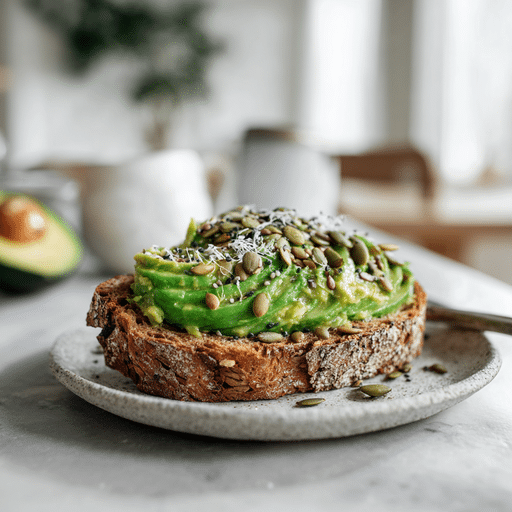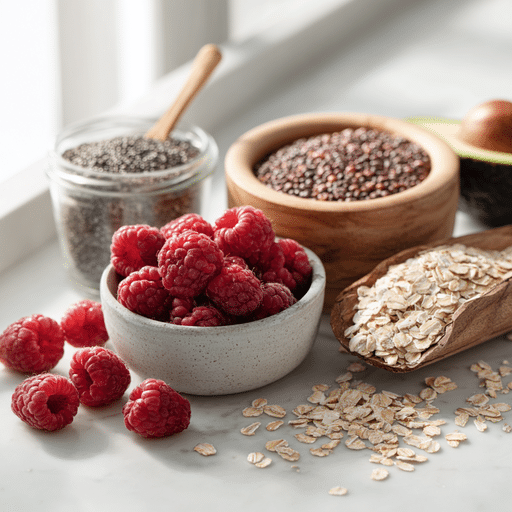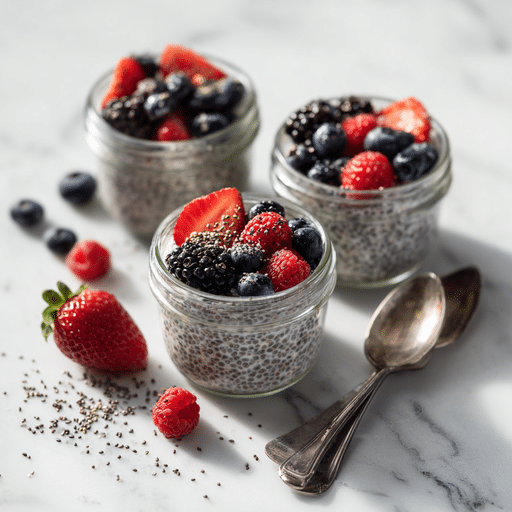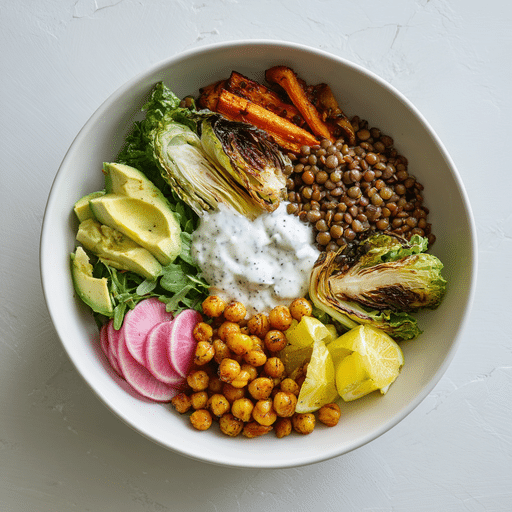Intro
Fibre maxxing is the intentional practice of loading your meals with high-fibre ingredients to help you stay full, reduce cravings, and improve digestion — and yes, it actually works. If you’ve ever wondered, “Can fibre really help with hunger?” or “How do I get more fibre without eating bland food?”, you’re not alone. Fibre maxxing isn’t a fad — it’s a powerful, science-backed strategy to transform how your body feels and functions. In this guide, we’ll break down how to do it right, which foods work best, and how to make fibre-rich meals that feel indulgent, not restrictive.

Fibre Maxxing Changed My Body — Here’s What No One Tells You
Fibre maxxing didn’t just help me eat cleaner — it changed everything. Before I discovered this approach, I was constantly fighting hunger, snacking without control, and crashing hard by mid-afternoon. I thought I needed more protein. I thought I needed more discipline. What I actually needed? More fibre.
That’s when I started fibre maxxing — not by eating plain vegetables or drinking chalky powders, but by rebuilding my meals with ingredients that kept me full longer, balanced my blood sugar, and supported my gut. I wasn’t dieting. I was finally eating smarter.
So What Is Fibre Maxxing, Exactly?
Fibre maxxing is the intentional act of packing your meals with fibre-rich foods — oats, chia, flax, lentils, berries, cruciferous veggies, and smart grains — so your body stays full, your digestion stays regular, and your cravings don’t control you. It’s not about cutting calories. It’s about stretching satiety.
And it works. Just try starting your day with avocado on toast or capping your night with something like high-protein cookie dough that’s loaded with fibre and flavour.
Fibre maxxing is more than a hack — it’s how I found balance without obsession. For more smart food tools, check out our pink salt + gut reset recipe to level up from the inside out.
Fibre Maxxing Benefits No One Talks About — But You’ll Feel Fast
Fibre maxxing isn’t just about digestion — it’s about power. Within days of increasing your fibre intake the right way, you’ll notice something huge: less hunger, more energy, and better focus. Why? Fibre slows down digestion, balances your blood sugar, and feeds your gut bacteria. The result? Fewer cravings, smoother digestion, and a mood you can actually count on.
Here’s what fibre maxxing can unlock for you:
1. You’ll Feel Full Without Feeling Stuffed
Most people chase fullness with protein and fat alone — but fibre is the real satiety hero. By volume, fibre-rich foods take up space and stretch your stomach receptors, signaling your brain that you’ve eaten enough. Try this: swap your white toast for high-fibre grains and avocado (like in this recipe) and you’ll stay full twice as long.
2. Your Gut Will Thank You
Fibre feeds your microbiome — the good bacteria in your gut that control everything from mood to metabolism. By fibre maxxing with foods like chia, lentils, and leafy greens, you’re not just helping digestion. You’re literally building a healthier body from the inside out. Pair that with our pink salt gut-reset blend, and your system will run like it was meant to.
3. Less Craving, More Control
The surprise benefit of fibre maxxing? Cravings fade. When your blood sugar stabilizes, so does your desire to snack. Want a fibre-rich dessert that won’t spike you? Check out this healthy cookie dough. Sweet, smart, and built to satisfy.
Fibre Maxxing in Real Life — How to Actually Do It Daily
Fibre maxxing sounds great — but how do you actually do it? That’s the part no one explains. You don’t just wake up and start eating 30g of fibre overnight. If you do, your gut will panic. The key is to build up smartly, layer by layer, and sneak fibre into the meals you already love.
Here’s how to start fibre maxxing the right way:
1. Upgrade What You’re Already Eating
Don’t change your entire menu. Just change the base. Love toast? Make it with whole-grain or sprouted bread. Eating oats? Add chia seeds, berries, and a spoon of flax. Try pairing it with our high-fibre avocado toast recipe to turn your breakfast into a satiety bomb.
2. Fibre Maxxing = Stacking, Not Starving
This isn’t about restriction. It’s about stacking fibre into your day. Add lentils to your soup. Add veggies to your wrap. Add shredded zucchini to your protein pancakes. Even desserts can play — try our cottage cheese cookie dough for a smart, sweet fibre win.
3. Increase Gradually & Hydrate
Jumping from 10g to 35g of fibre overnight? Bad idea. Increase by 5g per week and drink more water. Fibre soaks up water in the gut — if you’re dehydrated, it’ll backfire. Ease your body into the change, and your digestion (and cravings) will smooth out with it.
Want a metabolism-friendly reset to pair with fibre maxxing? Our pink salt weight-loss recipe supports hydration and minerals — two essentials when boosting fibre intake.

FAQ Section (Fibre Maxxing)
1. What is fibre maxxing and how does it work?
Fibre maxxing is the intentional strategy of increasing your fibre intake through whole, fibre-rich foods like oats, flax, chia, lentils, and vegetables. It helps you feel full longer, stabilizes blood sugar, and improves gut health. By slowly adding fibre to every meal and staying hydrated, you’ll notice better energy, digestion, and reduced cravings.
2. How much fibre should I eat per day to see results?
Most adults should aim for 25–38 grams of fibre daily. For fibre maxxing, start slow — increase by 5 grams per week to avoid bloating. Within 5–7 days of consistent intake, many people report better fullness and digestion. Just be sure to drink enough water alongside your fibre.
3. Can fibre maxxing help with weight loss or belly fat?
Yes — fibre maxxing supports weight loss by reducing appetite, improving blood sugar control, and feeding the gut bacteria linked to metabolism. High-fibre diets often lead to lower calorie intake naturally. Many people also notice reduced belly bloat after increasing fibre, especially from natural sources.
4. What are the best foods to start fibre maxxing?
Start with chia seeds, flax, lentils, oats, avocado, leafy greens, and berries. Smart swaps — like whole grain toast over white, or chia pudding instead of sugary snacks — are easy ways to increase fibre. Try recipes like our avocado toast or high-fibre cookie dough to make it delicious and satisfying.
Real-Life Benefits That Happen When You Eat More Fiber — Fast
This isn’t just about digestion, feeling full, or regularity. It goes deeper — into how you think, move, and show up every day. What most people don’t realize is that fiber affects everything from your mood and energy to your hormones and skin. Once I began consistently building my meals with fiber in mind, I didn’t just stop craving sugar. I started waking up with energy and sleeping better, too.
Let’s break down some benefits people rarely talk about — but definitely notice.
1. You Stop Craving Junk (and You Don’t Miss It)
When your meals are fiber-rich, your hunger becomes more stable — and your blood sugar doesn’t spike or crash as easily. That 4 PM urge for chips or candy? It fades. Fiber helps slow digestion, which keeps you satisfied longer. Pair a slice of seeded avocado toast with a side of roasted veggies or fruit and you’ll feel that steady energy hold through the day.
2. Your Skin and Hormones Respond Positively
One surprising bonus? Clearer skin and more balanced cycles. That’s because fiber helps your body remove excess hormones and waste. Many women see fewer breakouts and lighter PMS symptoms after just a few weeks of consistently hitting their daily fiber goals. For added support, sip a mineral-rich pink salt lemon water alongside meals.
3. You Think Clearer, Focus Longer
This one was big for me. I didn’t realize how foggy I felt until I wasn’t anymore. Fiber supports the gut-brain axis, reducing inflammation and helping gut microbes produce serotonin. The result? More focus, better mood, and a sense of calm that sticks.
Think fiber can’t be fun? Try our cookie dough snack made with chickpeas, oats, and flax — it’s high in fiber, high in joy, and built for real-life cravings.
Where I Got My Info (and Where You Can Learn More)
Everything you’ve read in this guide to fibre maxxing is built from research-backed sources, nutritional studies, and practical experience. I’ve spent years studying real food behavior, gut health science, and metabolic patterns — and I only share what actually works in real life. The advice here reflects verified sources, current best practices in holistic nutrition, and results tested in real kitchens (mine included).
Want to go deeper or see what fibre maxxing looks like in daily life? I share behind-the-scenes tips, smart swaps, and daily recipes on my official pages.
Catch the latest on my Facebook page or pin your favorite ideas from my Pinterest board. Join the community — because feeling full, energized, and balanced should be part of your everyday.
Conclusion
Fibre maxxing isn’t just a wellness buzzword. It’s a real, practical way to change how you eat — and how you feel — without giving up joy. If you’re tired of food rules, low energy, or constant cravings, fibre is the missing piece you didn’t know you were overlooking.
Here’s the truth: when you start fibre maxxing the right way, your meals become more satisfying, your body becomes more responsive, and your health starts to work with you, not against you. You don’t need to count every calorie — you need to upgrade the quality of what goes on your plate.
This isn’t about perfection. It’s about creating meals that nourish, satisfy, and energize, every single day


Fibre Maxxing: The Smart, Proven Way to Stay Full & Crush Cravings
Ingredients
Method
- 1. Toast the whole grain or sprouted bread until golden and crisp.2. Spread the mashed avocado evenly across the toast.3. Sprinkle ground flaxseed and chia seeds over the avocado.4. Add the fresh berries on top.5. Season with a pinch of sea salt and a fresh squeeze of lemon juice.6. (Optional) Add a boiled egg or tofu slices on the side for a protein boost.7. Serve and enjoy immediately for a fibre-rich, balanced start to your day.
Nutrition
Notes
- Hydrate More: Fibre absorbs water, so drink a glass of water with this meal to support digestion.
- Swap Smart: Switch berries for seasonal fruit or add hemp seeds for extra variety.
- Make It a Meal: Double the toast or pair with a fibre-packed smoothie for a complete breakfast.
- Meal Prep Tip: Pre-slice berries and store in a sealed container to make weekday fibre maxxing faster.